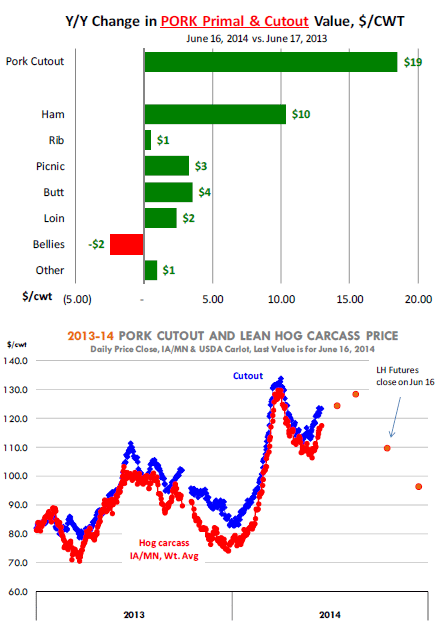



CME: Lean Hog Futures Turn Sharply Lower
US - Lean hog futures turned sharply lower this week, with the August contract down the daily permissible limit of 300 points. Overnight trading was steady to lower as well, according to Steve Meyer and Len Steiner.The sharp pullback in futures came at a time when both the cutout and cash hog prices notched significant gains compared to Friday levels. The cutout was quoted by USDA at $123.34/ cwt, $1.66/cwt higher than the Friday close and now $18.52/cwt (+18 per cent) higher than year ago levels.
The IA/MN Lean Hog carcass price was quoted on Monday afternoon at $117.45/cwt, $0.95/cwt higher than the Friday close and about 17 per cent higher than year ago levels. Cash hog prices have been on an upswing recently, with IA/MN prices adding almost $9/cwt since the beginning of June.
Those higher prices have been one of the main reasons why July and August futures hit record contract highs last week. But despite the gains in yesterday’s cash markets, there are plenty of questions lingering in the hog and pork complex about price performance in late summer.
The memory of what happened in March and early April is still quite fresh. Back then, a combination of panic buying and rampant speculation about the shortfall in hog supplies this summer pushed pork and hog prices to all time record highs.
As the frenzy subsided, we saw futures quickly remove some of the premiums on the May and June contracts while cash hog prices eased lower. The question in many people’s minds is if we are setting up to repeat the same pattern, especially if hog numbers come in above some of the more bullish estimates out there.
USDA quoted the daily hog slaughter yesterday at 375,000 head, only about 15,000 head smaller than the comparable Monday a year ago. Last week, we saw Tuesday, Wednesday and Thursday hog slaughter average about 410,000 head, much higher than the previous year and above any of the estimates out there.
It appeared that packers were quite aggressive in trying to source hogs and paid a premium to keep their lines full. From a seasonal perspective, that makes a lot of sense. We are coming into the 4th of July Holiday weekend and normally grilling demand tends to improve. This year the holiday may have more of an impact since it is on a Friday and consumers are gearing up for a long weekend.
So packers looking to fill holiday orders and running heavy slaughter would benefit the spot cash market, hence the higher cash hog prices. That does not do much, however, for hog prices in July and August – unless of course all the forecasts for short, PEDv-induced slaughter turn out to be true.
There are three concerns out there as we see it:
- the impact of a lower seasonal for a number of items (loins, butts, ribs) after 4 July holiday
- extremely heavy carcass weights that so far have offset much of the decline in hog slaughter
- export demand for hams in July and August.
On the first count, it is always important to recognize seasonal tendencies for prices of specific cuts. While there are always exceptions and years when prices move counter-seasonally, it is always a risky proposition to bet against the seasonal. In recent years, the pattern has been for pork loins, pork butts, ribs and to a lesser extent picnics, to pull back in early to mid July.
As you can see from the following chart, the gains in these three primals have contributed almost half of the gain in the overall cutout. Carcass weights are extremely heavy and if packers pulled hogs forward in the last week, it seems to have had no impact on weights.

Producer weights (based on MPR) have averaged 216 pounds in last seven days, 5.8 per cent higher than a year ago. There are some very heavy hogs out there. Finally, the issue of exports is extremely important.
We think a big reason for the gains in ham prices is due to export demand in Mexico, Asia, South America and even Russia. In other years, we have seen export orders pull back during July and August as they don’t want to compete with domestic end users.
As you can see above, ham values have contributed more than half of the gains in the cutout and remain a critical factor in supporting overall cut-out values.








